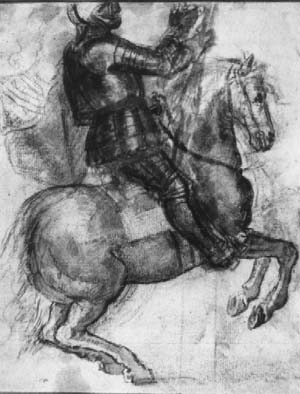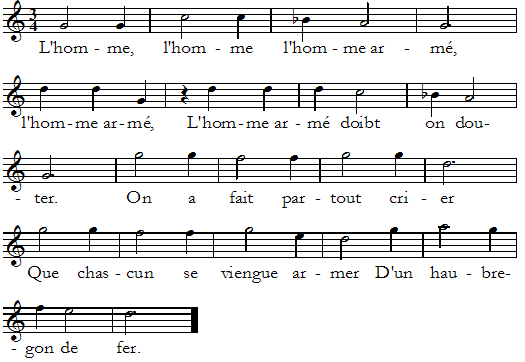
Van Dyck: Study for an Armed Man on Horseback
If there can be said to be a hit song of the early Renaissance this would be it. Attributed to any number of Burgundian composers, and commonly understood as a secular song, this work became the cantus-firmus for some forty to fifty Catholic masses during the mid-fifteenth century. Just who the "Armed Man" is has been a subject of much debate. Some have argued that the "Armed Man" is the enemy: unemployed former militiamen and brigands who roamed the Burgundian countryside at the end of the Hundered Years War. Others suggest that the "Armed Man" is the civilian voice of the poem: in the 1450s archers were recruited to watch over cities in Burgundy, a National Guard of sorts; the "Armed Man" could thus be announcing his own power. A third theory states that the song may have arisen from courtly festivities in which an "Armed Man" was mocked in a play of sorts. Finally, other scholars believe the tune may have been associated with a certain Symonet Le Breton who had an unlikely encounter with one "dreaded Turk" that led to a new Crusade by the Order of the Golden Fleece in the 1430s or 1440s. It seems likely that the song was a motto of sorts for the Order of the Golden Fleece.
This melody is in three phrases, of which the last is a repeat of the first. (ABA). The meter of the poem is reflected in the triple meter of the song. The melody itself is strongly connected to the natrual scale and focuses on the tonic (the first note: do) and dominant (the fifth note: sol), the most stable pitches of the scale. Further there is a marked contrast in register between the first and second phrases; the second is significantly higher in pitch than the first. All in all, it was well-suited for polyphonic elaboration and for the changing mores in harmonic theory that were beginning to take root.
